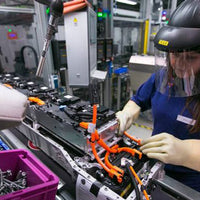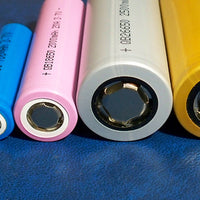The development of Li-ion battery technology has been focused on controlling cost, improving energy density and power density of Li-ion batteries, enhancing safety in use, extending service life and improving pack consistency, etc., and the enhancement of these elements remains the biggest challenge for Li-ion batteries today. The inconsistency of a single cell is an important factor affecting the performance of the battery pack, which can reduce the available capacity of the battery pack and reduce the cycle life of the battery pack.
Analysis of the inconsistency problem of Li-ion battery packs
The cycle life of a single cell will be reduced when it is formed into a pack. The selection of longer service life of the single-cell battery pack synthetic battery pack will increase the number of battery pack cycles, but to improve the overall performance of the battery pack, to obtain long service life should also pay attention to the single-cell battery matching consistency, to provide suitable working conditions and the use of appropriate thermal management measures, timely repair, and maintenance. Based on the analysis of the causes of the inconsistency of the lithium-ion battery pack, improvement measures and optimization methods for the battery inconsistency are proposed.
Part 1 Inconsistency mechanism
1. Differences in parameters between single cells
The state differences between single cells mainly include the initial differences of single cells and the parameter differences generated during the use process. There are various uncontrollable factors in the battery design, manufacturing, storage, and use process that can affect the consistency of the battery. Improving the consistency of single cells is a prerequisite for improving the performance of the battery pack. In the interaction of single-cell parameters, the current parameter state is influenced by the initial state and the cumulative effect of time.
Battery capacity, voltage, and self-discharge rate.
Inconsistent battery capacity will cause inconsistency in the depth of discharge of each cell in the battery pack. The battery with a smaller capacity and poorer performance will reach the full charge state earlier, causing the battery with a larger capacity and better performance to fail to reach the full charge state. Battery voltage inconsistency will lead to a parallel battery pack in the single battery charging each other, the higher voltage battery will give the lower voltage battery charging, which will accelerate the battery performance decay, and loss of energy of the whole battery pack. The large self-discharge rate of the battery capacity loss and the inconsistency of the self-discharge rate of the battery will lead to differences in the battery charge state, and voltage, affecting the performance of the battery pack.
Battery internal resistance
In a series system, the difference in the internal resistance of a single battery will lead to the inconsistent charging voltage of each battery, and the battery with large internal resistance will reach the upper voltage limit in advance, and other batteries may not be fully charged at this time. The battery with large internal resistance has high energy loss and generates high heat, and the temperature difference further increases the difference in internal resistance, leading to a vicious cycle.
In a parallel system, the difference in internal resistance will lead to the inconsistency of each battery current, and the voltage of the battery with high current changes quickly, making the charging and discharging depth of every single battery inconsistent, causing the actual capacity value of the system to be difficult to reach the design value. The battery operating current is different, and its performance will be different in the process of use, which will eventually affect the life of the whole battery pack.
2. Charging and discharging working conditions
Charging mode affects the charging efficiency and charging state of the lithium battery pack, overcharging and over-discharging will damage the battery, and the battery pack will show inconsistency after multiple charging and discharging. At present, there are several ways to charge lithium-ion batteries, but the common ones are segmented constant-current charging and constant-current constant-voltage charging. Constant current charging is the more ideal way to carry out a safe and effective full charge; constant current and constant voltage charging effectively combine the advantages of constant current charging and constant voltage charging, solving the problem of the general constant current charging method is difficult to accurately full charge, avoiding the impact of constant voltage charging method on the battery caused by the excessive current in the early stage of charging, simple and convenient operation.
3. Temperature
The performance of the Li-ion battery will be significantly degraded at high temperatures and a high discharge rate. This is because the lithium-ion battery in high-temperature conditions and high current use, will cause the decomposition of the positive active material and electrolyte, which is the exothermic process, a short time to release heat can lead to a further increase in the temperature of the battery itself, the temperature rise and accelerate the decomposition phenomenon, forming a vicious circle, accelerating the decomposition of the battery performance further decline. Therefore, if the battery pack thermal management is not appropriate, it will bring irreversible performance loss.
Battery pack design and use of environmental differences will cause the single battery temperature environment to be not consistent. It is known from Arrhenius' law that the electrochemical reaction rate constant of the battery is exponentially related to the degree, and the electrochemical characteristics of the battery are different at different temperatures. Temperature affects the operation of the battery electrochemical system, coulombic efficiency, charge/discharge capacity, output power, capacity, reliability, and cycle life. Currently, the main research carried out is the quantitative study of temperature effects on battery pack inconsistency.
4. Battery external circuit
Connection method
In a scale energy storage system, the batteries will be put together in series-parallel, so there will be many connection circuits and control elements between the batteries and modules. Due to the different performance and aging rates of each structural member or component, as well as the inconsistent energy consumption of each connection point, different devices have different effects on the battery, resulting in inconsistent battery pack systems. The inconsistent rate of battery decay in parallel circuits accelerates the deterioration of the system.
The impedance of the connection piece will also have an impact on the inconsistency of the battery pack. The resistance value of the connection piece is not the same, and the resistance value from the pole to each single cell branch is different, and the battery far from the pole has a higher resistance value and lower current due to the long connection piece.
As the number of battery cycles increases, it will cause the ohmic internal resistance to increase, capacity decay, and the ratio of ohmic internal resistance to the resistance of the connecting piece will change. To ensure the safety of the system, the influence of the resistance value of the connection piece must be considered.
BMS Input Circuit
The battery management system (BMS) guarantees the normal operation of the battery pack, but the BMS input circuit can adversely affect the consistency of the battery. Battery voltage monitoring methods are precision resistor voltage divider, integrated chip sampling, etc. These methods can not avoid sampling line external load leakage current due to the existence of resistors and board pathways, and the battery management system voltage sampling input impedance will increase the inconsistency of the battery state of charge (SOC) and affect the performance of the battery pack.
5. SOC estimation error
SOC inconsistency arises from an inconsistent initial nominal capacity of single-cell batteries and an inconsistent decay rate of the nominal capacity of single-cell batteries during operation. For a parallel circuit, the difference in the internal resistance of a single cell will cause uneven current distribution, which in turn leads to inconsistent SOC. SOC algorithms include the ampere-time integration method, open-circuit voltage method, Kalman filter method, neural network method, fuzzy logic method, discharge test method, etc.
The ampere-time integration method has better accuracy when the starting charge state SOC0 is more accurate, but the Coulomb efficiency is influenced by the state of the battery charge state, temperature and current, etc., which is difficult to measure accurately, so it is difficult for the ampere-time integration method to achieve the accuracy requirement of the charge state estimation. The open-circuit voltage method has a definite function relationship between the open-circuit voltage and SOC of the battery after a longer period of standing, and the estimated value of SOC is obtained by measuring the terminal voltage. The open-circuit voltage method has the advantage of high estimation accuracy, but the disadvantage of long resting time also limits its use.








0 comments